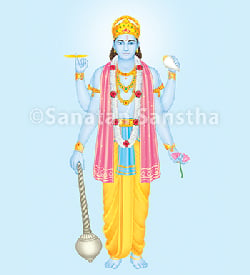
Contents
1. Origin and meaning
‘Yaska has derived this word from vish (विष्) which means to be constantly active (Nirukta 12.19). Yaska has also opined that the word Vishnu has also been derived from vish (विश्) which means to pervade and based on this Sayanacharya too has given its meaning as vast or all pervading (the commentary of point 1.154.1 and 5 of the Rugveda). In accordance with this meaning a commentary on the Vishnusahasranam says -‘चराचरेषु भूतेषु वेशनाव्दिष्णुरुच्यते|’
Meaning: He is called Vishnu because He pervades all the animate and inanimate creation.’
2. Some other Names associated to Lord Vishnu mantra
The famous verse of Lord Vishnu is the Vishnusahasranam (विष्णुसहस्रनाम). Amidst chanting of these thousand Names Lord Vishnu is ritualistically worshipped with an offering of tulsi leaves or lotus flowers while sipping water through the palm (achaman).
During the ritual of sandhya the twenty-four Names recited are – Keshav, Narayan, Madhav, Govind, Vishnu, Madhusudan, Trivikram, Vaman, Shridhar, Hruíhikesh, Padmanabh, Damodar, Sankarshan, Vasudev, Pradyumna, Aniruddha, Puruíhottam, Adhokshaj, Narsinha, Achyut, Janardan, Upendra, Hari and Shrikrushna. Although all these Names belong to Lord Vishnu, yet according to the rule that sound, touch, form, taste, fragrance and energy coexist with a word how a different energy is generated by chanting each of these Names will be understood from the following lines of a verse.
शयने पद्मनाभं च विवाहे च प्रजापतिम् ।।१।।
युध्दे चक्रधरं देवं प्रवासे च त्रिविक्रमम् ।
नारायणं तनुत्यागे श्रीधरं प्रियसंगमे ।।२।।
दु:स्वप्ने स्मर गोविन्दं संकटे मधुसूदनम् ।
कानने नारसिंहं च पावके जलशायिनम् ।।३।।
जलमध्ये वराहं च पर्वते रघुनन्दनम् ।
गमने वामनं चैव सर्वकार्येषु माधवम ।।४।।
Meaning: One should contemplate on Vishnu when consuming medicines, Janardan when eating, Padmanabh when sleeping, Prajapati during a marriage ceremony, Lord Chakradhar (Vishnu / Krushna) when fighting a battle, Trivikram during a journey, Narayan at the time of death, Shridhar during intercourse between spouses, Govind in case of a bad dream, Madhusudan in a calamity, Narsinha in the forest, the form of Vishnu in the celestial ocean (kshirasagar) when threatened by fire, His Varaha incarnation when there is fear of drowning, Raghunandan when there is fear of fall from a mountain and Madhav when performing day-to-day chores.
One will realise from the following examples why certain Names of Lord Vishnu (also commonly known as Lord Vishnu mantra ) are used for a particular mission.
Since Prajapati created the universe and is responsible for procreation during a marriage ceremony His ( Lord Vishnu mantra ) Name is chanted.
During a fight the Name of Vishnu ( Lord Vishnu mantra ) who sports a discus (chakra), Chakradhari should be chanted.
Since the lion is the king of the forest if one chants the Name of Narsinha (the man-lion incarnation – Lord Vishnu mantra ) in the forest one is protected.
The Varaha (boar) incarnation of Lord Vishnu lifted the earth from the waters and placed it on the head of the serpent, Shesh. Hence when there is fear of drowning this ( Lord Vishnu mantra ) Name should be chanted.
A. Bhagvan
The six attributes namely wealth, Righteousness (Dharma), success, opulence, spiritual knowledge and detachment are referred to as ‘bhag’. The one who possesses these attributes is called Bhagvan. In the Bhagvat sect Lord Shrikrushna and Vishnu are referred to as Bhagvan.
B. Narayan
‘This is a deity from the post Rugvedic period. The word narayan (नारायण) has been derived from nar (नार) [naraha (नारा:)] = apa (आप) meaning the absolute water element and ayan (अयन) meaning a place. Thus it means that the one who lives in the apa element is Narayan. The water mentioned above should not be considered as mere water. Before the earth came into existence everything was in the form of the apa element. Later it is from this that the universe was created. The origin of what we refer to as water occurred through a physical process much later. The all pervading energy which was present in the very beginning is the one referred to as water in this context. So, that principle from which the universe has been created is Narayan.’
‘Nara’ refers to mankind and ‘ayan’ to its ultimate stage is another definition of Narayan.
Synonymous words in the Narayaniya sect and other philosophies
Narayaniya sect Other philosophies A. Name Sahasrashirshapurush, (The thousand-headed
Being) (Tripad)Parabrahman,
ParameshvarB. Forms 1. Unmanifest form He is Supreme, beyond the three components
(guns). He is called the
tripad nectar (amrut)Supreme Brahman
(Parabrahman),
Supreme God
(Parameshvar)2. Manifest form
भूमिं विश्वतो वृत्वा अत्यतिष्ठत्
दशाङ्गुलम् means the space equivalent to the
width of ten index fingers
remaining after
encompassing all the regions of the universe.Brahman, God (ishvar) 3. Vast (virat) form Conception from the vast form occurs in Prakruti Apa (absolute water),
form of the
universal intellect
(Mahat principle),
the Great Illusion
(yoni), PrakrutiC. Energy Narayani The female deity (devi),
spiritual energy (kundalini)D. Creation of the universe 1. From what? Tinkling of the vina (a stringed musical
instrument) strings of
Sage NaradAkash (absolute ether) 2. Characteristics Sound (nada) Word (shabda) Sheshashayi: ‘This is one form of Narayan. He reclines on the serpent (nag) who is the king of hell (patal). In the word “patalam (पातालम्)” the word alam (आलम् ) is derived from the Tamil language and refers to water. Water is not called alam in Sanskrut. Nag is the name of a Dravidian tribe and Shesh was probably their ancient king or family deity.
Shvetadipa: Just as Vishnu’s abode is Vaikunth, Shiva’s is Kailas, so also Narayan’s abode is Shvetadipa.
Nara-Narayan: This is considered as a pair of deities. Both of them are friends and have originated from the same principle. This idea was probably derived from the Vedic verse “Dva suparna” (Rugveda 1.164.20). This verse means : There are two birds seated on a tree. Both of them are beautifully winged, close friends living together. One of them tastes sweet fruits of that tree. The second however does not eat but merely adopts the stance of a spectator. Thus in the above quote the one feasting on the fruit is nara (man) and the spectator is Narayan.’
Nara Narayan 1. Components (guns) Composed of guns (sagun) Beyond components (nirgun) 2. Spiritual meaning The embodied soul or the
Great Illusion (Maya)Shiva or Brahman 3. Idol Has two arms Has four arms 4. Incarnation Arjun Krushna Navanarayan and Navanath: The Navanarayans nurture the nine serpents (nag) in the universal spiritual energy system (vishva kundalini).
‘The group of nine saints from the Nath sect constitutes the Navanaths. The holy text Navanathbhaktisar enumerates the couplets of the Navanaths and the Navanarayans whose respective incarnations they are:
Navanath Whose
incarnation?Navanath Whose
incarnation?1. Matsyendra Narayan 6. Nag Avirhotra 2. Goraksha Hari 7. Bhartruhari Drumil 3. Jalandhar Antariksha 8. Revan Chamas 4. Kanif Prabuddha 9. Gahini Karbhajan 5. Charpati Pippalayan From the various compositions about the Navanaths it appears that though some Names of saints correspond, there is no uniformity. The concept of the Navanaths probably originated from the school of thought that the Navanaths are the presiding deities of the nine openings in the body (navadvar). Later the one who felt drawn to particular Naths must have included them in the nine saints and published his list of Navanaths. The list of Navanaths is similar to that of the six Manus, the seven great sages (Saptarshi), Ashtachap, Navanarayans, the sixty-three saints (Tamil Shaivites), etc. In the Shaiva sect the Navanaths hail from the Adinath (that is Shiva) lineage.’
Idol of Narayan: ‘According to the Dravidians Narayan was considered as a form of Lord Shiva. This idea of unity of Narayan and Shiva will be clear after seeing the idols of Narayan at Shivasamudram, Shrirangam and Shrirangapattanam in India. In South India, Narayan Himself is called Shriranga or Ranganath. Among the three places of pilgrimage mentioned above, Shivasamudram is basically a Shaivite place of pilgrimage. The characteristic of Narayan’s idol is that it is always in a reclining posture. However it is not asleep as its eyes are half open.’
Narayani : In the Vaishnav sect the Mahanarayan radiance [spiritual energy (kundalini)] in the body is referred to as Narayani.
C. Vasudev
Vasaha (वास:) means life, sustenance or stability. The deity bestowing this is known as Vasudev (वासुदेव).
सर्वाणि तत्र भूतानि वसन्ति परमात्मनि ।
भूतेषु च स सर्वात्मा वासुदेवस्तत: स्मृत: ।।Meaning: He is referred to as Vasudev (vas means to stay) because all objects created from the five elements reside within Him and vice versa.
D. Sankarshan
Samyak (सम्यक्) and karshan (कर्षण) constitute the Name Sankarshan (संकर्षण). Sankarshan thus means the one who attracts unhappiness or illness and guides one to the level of equanimity. He is the one who attracts or gets rid of any kind of inappropriate frequencies and transforms them into appropriate ones.
E. Kiritdhari
Kiritdhari means adorning a crown (Kirit). Among the superior deities Lord Shiva does not wear a crown. It is in this context that Vishnu is said to be wearing a crown.
F. Lakshmipati
Vishnu’s feminine form is called Lakshmi. Laksham means concentration. The one who can be acquired with concentration is called Lakshmipati (Master of Lakshmi).
G. Hari and Shrihari
1. Hari: ‘यस्य अनुग्रह्य इच्छामि तस्य सर्वं हराम्यहम् ।’
Meaning: Whenever I bestow My grace on someone, I take everything (including unhappiness) from him. (Hence My Name is Hari.)2. Shrihari: Shri refers to attributes such as energy, beauty, virtues, etc. Vishnu’s form along with Shri is Shrihari.
Reference: ‘Vishnu and His forms’, Published by Sanatan Sanstha.

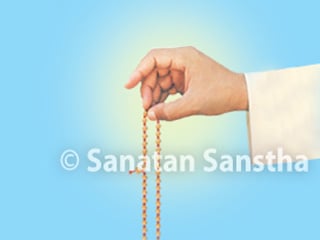
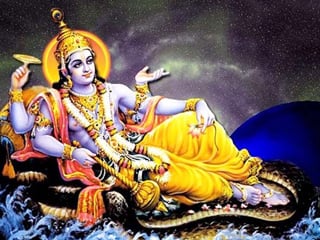 What are the implied meanings of the ten incarnations of Lord Vishnu ?
What are the implied meanings of the ten incarnations of Lord Vishnu ? What does the lotus in the hand of Lord Vishnu symbolize?
What does the lotus in the hand of Lord Vishnu symbolize?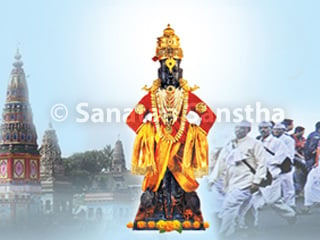 What does the idol of Lord Vitthal with His hands on the waist signify?
What does the idol of Lord Vitthal with His hands on the waist signify?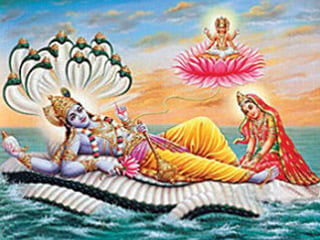 Why is Lord Vishnu called as foremost Guru?
Why is Lord Vishnu called as foremost Guru?